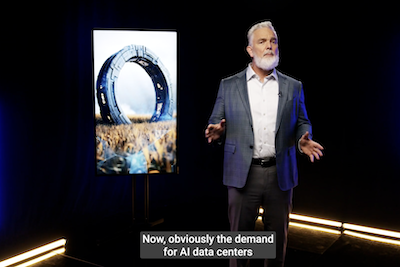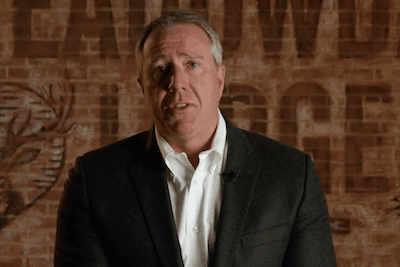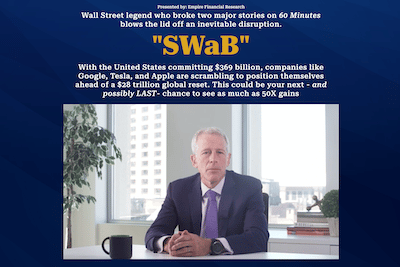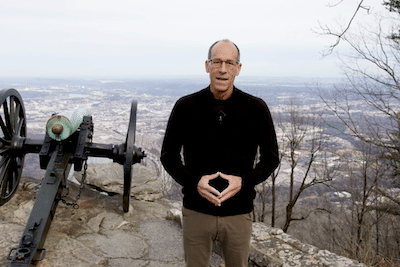Whitney Tilson has just released a new (September 2022) presentation centered around the energy sector, which he believes is entering a “supercycle.”
According to Tilson, he and his colleagues foresee a “mass exodus” coming as soon as November that could result in a “large transfer of wealth out of the tech sector” and into “the Keystone Sector” (aka energy sector).
Furthermore, Tilson says there’s one “$4 stock” at the “center of it all,” which he refers to as “the next LNG powerhouse,” and he thinks it could see a 400% gain.
“A mass ‘exodus’ is underway… and it could trigger a historic bull market in one specific sector… one that’ll last anywhere from five to 10 years and hand early investors the chance to make 400% gains.”
[…]
“My colleagues and I foresee a large transfer of wealth out of the tech sector and into what I call ‘the Keystone Sector.’ I’ll explain what this means in just a second.”
[…]
“… If we didn’t have energy, we’d still be living in the stone ages. That’s why I call it ‘the Keystone Sector.’ It’s the critical piece that holds the whole economy together.”
[…]
“The stage is set for an energy bull market unlike anything we’ve seen in our lifetimes… and the exodus coming on November 1 will only accelerate this supercycle.
“I’ve identified not one… not two… but TEN ways to play this boom for massive profits – including a $4 stock at the center of it all.”
Source: https://secure.empirefinancialresearch.com/?cid=MKT672421&eid=MKT675672&assetId=AST261724&page=2
Long story short, it was all part of a pitch for a new service Tilson and his team have launched called Energy Supercycle Investor, which costs $2,000 per year.
Marketing hype aside, this was one of the more interesting presentations I’ve come across in a while. And it was quite different from the majority of Tilson’s presentations I’ve covered, which have mostly been tech- and biotech-focused.
I have no idea if Tilson’s predictions will play out or not, but in this post, I’ll do my best to break down his thesis and show you what “$4 stock” I think he’s teasing.
Whitney Tilson’s “Energy Supercycle” Prediction
The gist of Whitney Tilson’s latest prediction is that a huge amount of capital could be about to leave the tech sector and flow into the energy sector, which he believes could be entering a so-called “supercycle.” And he specifically focused on the oil and gas space.
“But if you look outside the scope of indexes… to the hyper-intellectual and lucrative world of hedge funds… you’ll see that those folks are doing the exact opposite.
“They’re discarding their tech stocks and pouring their wealth into ‘the Keystone Sector.'”
In the presentation, Tilson referred to the energy sector as the “Keystone Sector” because, according to him, it’s the “critical piece that holds the whole economy together.”
And he said that the market has just experienced “three major catalysts” that could send energy on a “multiyear supercycle” that could generate “huge returns” for investors who get in before November 15.
“This market has just experienced three MAJOR catalysts, and they’re going to send energy on a multiyear SUPERCYCLE that could generate huge returns for investors who get in BEFORE November 15.”
What’s happening on November 15?
To me, this is at least partly a marketing gimmick. But it basically relates to what Tilson says is the “deadline for big investors to let hedge funds know they’re withdrawing money.”
In short, Tilson believes that this date could “mark a turning point for the energy sector,” where hedge funds start investing more heavily in energy to turn around their performance and hold onto their clients. In other words, the presentation is suggesting that November could mark the “exodus” of when money starts flowing out of tech and into energy.
Something like that, anyway.
What “major catalysts” does Tilson believe could send energy into a “supercycle?”
According to Tilson, the first “Energy Supercycle Catalyst” is a lack of oil supply:
“First off, there’s a supply deficit in the energy market.
“There simply isn’t enough supply to meet demand.
“The world is consuming about 10 million more barrels a day than we produce – and that is draining inventories.”
Shortly after that, Whitney Tilson and Elaine Espinola (the host of the presentation) introduced Harris “Kuppy” Kupperman, an energy investment expert who runs a hedge fund called Praetorian Capital. And he pointed out that the reason crude inventories are so low comes down to supply and demand.
“It’s just supply and demand. And the cure for low prices is low prices, and the cure for high prices is high prices.”
That’s an interesting way of putting it and made me stop and think.
Basically, what he’s saying there (at least from my perspective) is that higher prices attract more investment into things like exploration and drilling, which increases supply, which eventually leads to lower prices.
Then, as the price of oil comes down, investment in the space drops off, decreasing supply, and eventually bringing prices up before the cycle starts over again.
That’s the gist of the supply/demand dynamic, anyway.
And as for the “supercycle” aspect of the pitch… Tilson didn’t really elaborate on how he defines a supercycle, but the basic concept is that commodities and energy market can be especially cyclical, and the presentation basically suggests that we could be entering into a major bull market for energy, where demand far outstrips supply.
What about electric vehicles?
Wouldn’t these drive demand for oil lower?
Most of the Whitney Tilson presentations I’ve seen suggest that he’s a huge EV bull, but in this presentation, he said that the “transition” (toward EVs) could take decades to happen. So it doesn’t appear as though he thinks the push toward EVs will slow down demand for oil and gas anytime soon.
“Look, my colleagues and I have been talking up the transition to electric vehicles for years now. But the reality is that this transition will take many years – perhaps even decades – to happen.
“Will there be chances to invest and make money in EVs along the way? Of course. Our readers have already doubled their money twice on our TaaS recommendations.
“But until we build out the infrastructure to ease mass adoption of renewable energy, fossil fuels will continue to power our world. For many, that’s a hard pill to swallow, but it’s the truth.”
What about the second “catalyst?”
According to Tilson, the second “Energy Supercycle Catalyst” is that there aren’t enough refineries to process the oil that has been pumped.
“There aren’t enough refineries to process the oil that we have pumped.
“Did you know it’s been 45 years since the last major refinery was built in America?”
[…]
“Since then, not only has no company built any refineries with comparable capacity in the U.S…
“More than HALF the refineries in America have closed.”
As for the third “catalyst,” this coincides with the last one in that, according to Tilson, most U.S. oil companies are refusing to pump more oil.
“Most U.S. oil companies refuse to pump more oil.”
[…]
“Instead of financing drilling anywhere and everywhere, oil companies are limiting their investments to only their most profitable projects, and instead allocating excess cash to boosting their dividends and buying back shares.”
This is a similar point that Brett Eversole made in a recent Stansberry Research presentation I wrote about centered on Steve Sjuggerud’s “oil boom” stock picks. Namely, that despite higher oil prices, oil companies aren’t doing as much drilling as they could be and are instead plowing the profits back into dividends and buybacks.
As for why; Tilson suggests that it has to do with a fear of overproducing:
“… oil companies have PTSD from overproducing during boom times and seeing it blow up in their faces, they’re not willing to get burned again.”
Kupperman took this idea a step further by talking about the oil futures market and how the oil price is in backwardation, meaning the spot price of oil is higher today than it’s forecasted to be years into the future.
This matters because oil companies plan out their projects potentially decades into the future, so they need to make sure their projects will be profitable.
Here’s how Kupperman put it:
“And if you look at an oil curve, the front month is the volatile month. But when you go back into some of the back months, you go back two or three years and you look at where the price of oil is in 2023 and look at where oil is in 2025. I mean, as of this filming, oil is at $70 in 2025.
“So everyone fixates on oil being $90 today on the front side. But look at $70. And a lot of these wells, I mean, they’re not economic at $70.”
[…]
“And so if something’s not economic at $70, you’re not going to produce it at $70, and no one cares that it might be economic at $90 because you can’t hedge it because where the curve is, is $70.
“And so until the curve moves, it moves into a price level where it’s economic to both produce and hedge because your bank is going to make you hedge if they lend you money to go drill.
“They’re not going to do it. And I think a lot of people are really fixated on the front month and they’re forgetting that when you drill an oil well, it lasts for 10 or 20 years minimum. And people are looking at the back months and saying, how do I hedge this and lock this in?
“And they can’t lock it in. And as a result, they’re not drilling. It’s all just hard. You need higher prices to solve all these problems.”
I don’t know what the future price of oil will be, but I did find it interesting to get both Tilson and Kupperman’s perspectives on the energy sector, as gaining a deeper understanding of what moves markets can help you make more sense of what’s going on.
So with all that said, what company is Tilson pitching?
The first pick Tilson discussed is one he gave away for free, Occidental Petroleum (OXY), which he says he started looking into after discovering that Buffet was buying.
“It goes without saying that there’s no investor I admire more than Buffett.
“So when I saw that he was aggressively buying Occidental Petroleum, I rolled up my sleeves and got to work.
“I quickly realized that his position amounted to a huge wager on the coming energy supercycle. You see, Occidental generates a whopping 70% of its revenue from oil and gas.”
[…]
“The stock symbol is OXY, and I recommend you do not pay more than $80 per share.”
But that was just the “free pick” he shared.
The main company Tilson pitched in the presentation is one he refers to as “the next LNG powerhouse,” and the only way to find out what that is is to see the report he created called “400% Upside: The $4 Stock at the Center of the Energy Supercycle.”
I haven’t read that report because you need to join his Energy Supercycle Investor service to access it, which costs $2k, and I’m not interested in joining any other services right now. But I did look into the clues he shared and think I know what company he’s teasing.
So let’s look into Tilson’s pick now.
What’s Tilson’s $4 “Next LNG Powerhouse” Pick?
Tilson’s thesis on this company centers around how the U.S. is “overflowing with natural gas” while the situation in Europe is the opposite, and prices are through the roof.
And he believes that a “tiny” U.S.-based company could “step in to save the day.” In other words, he thinks the company he’s teasing could supply Europe with natural gas.
But as he pointed out, the problem is getting natural gas from the U.S. to Europe profitably without a pipeline (which is out of the question given the distance).
So the answer, according to Tilson, could be exporting liquified natural gas (LNG) to Europe, which he suggests that the company he’s teasing may be able to help with.
Here’s what Tilson said about this company:
“Once liquified, natural gas can be shipped and traded on the global market, serving Europe’s needs and relieving its dependence on Russian gas.
“In fact, Germany is fast-tracking the building of several LNG import facilities.
“A small firm we call ‘the next LNG powerhouse’ is set to feed this growing demand – and today you can get in on the ground floor.
“This company is building an integrated LNG business, the first of its kind in the U.S. That means it’ll control every aspect of the business.
“‘The next LNG powerhouse’ will drill for natural gas… funnel it through a pipeline to an LNG facility… then ship it out to the global markets at an absurdly lucrative 5 times premium.
“It’s secured all the critical permits. The Department of Energy and the Federal Energy Regulatory Commission are all on board.
“It’s contracted Bechtel – the builders of the Hoover Dam and about a third of all LNG facilities around the world – to build its LNG terminal.
“And it’s led by a man Forbes calls ‘one of the Founding Fathers of the LNG movement.’
“This man turned his last company into the second largest LNG exporter in the world… and he’s about to do it again.
“He’s building a MEGA-TERMINAL that’ll send 28 million tons of LNG around the world every year.”
Based on those clues, Tilson’s pick appears to be Tellurian Inc. (ticker: TELL), a Texas-based natural gas company founded in 2016.
The clue that led me to this conclusion was the above Forbes quote, which was referring to Charif Souki. And a quick Google search revealed that Charif Souki is the co-founder and Executive Chairman of the Board of Tellurian. So that’s how I uncovered this one.
As for how the other clues match…
- The stock is currently sitting at just under $4, which matches Tilson’s hints about it being a “$4 stock.”
- And according to ogj.com, the company’s planned Driftwood LNG export plant is a “27.6 million tonne/year” project located in southwestern Louisiana, which lines up (rounding up) with the last clue Tilson shared (above).
That last article I shared is very recent and could be worth a read if you’re interested in this company, as it outlines some of the details of its project.
There’s also an interesting article breaking down the investment case for Tellurian on Seeking Alpha that you might find helpful.
As for whether this company is a good investment or not, I’ll leave that to you to decide. I don’t make predictions about stocks, nor am I a stockpicker. But this appears to be the “next LNG powerhouse” Tilson referred to in the presentation.
If you want to find out what Tilson is recommending for sure and get all the details, the best thing to do would be to see the report he’s put together. And as mentioned, the only way to do that would be to join his Energy Supercycle Investor service.
Recommended: Go here to see my #1 rated stock advisory of 2024
Should You Join Energy Supercycle Investor?
Energy Supercycle Investor is a new Empire Financial Research service run by Whitney Tilson focused on energy-related investments.
The cost to join is $2,000 as part of the presentation, and as a subscriber, you get access to the report I mentioned earlier, as well as a report on Occidental Petroleum and one called “The Energy Supercycle Portfolio,” which details other energy companies he’s tracking.
Aside from that, subscribers get access to an eight-week trial of Kupperman’s newsletter, called Kuppy’s Event-Driven Monitor, and other resources, including a video series.
Is it worth it?
I’m not a member of this service, so I can only speculate as to how worthwhile it might be, but at the very least, I’d say it could be worth a look. I say that because Tilson is a former hedge fund manager with a decent track record, and I have found his insights to be pretty interesting since I started writing about his predictions and picks.
Also, Kupperman is an expert in the energy sector who runs a successful hedge fund, so getting access to a trial of his service is a nice bonus.
Keep in mind, however, that regardless of how successful any stockpicker is or what may or may not happen in the oil and gas market, there’s no guarantee you’ll make money by signing up and following the recommendations.
As with any service, there are always risks involved.
Bottom Line
Tilson’s “Energy Supercycle” presentation makes a compelling case as to what may lie ahead for the energy sector, particularly as it relates to oil and gas.
Tilson isn’t the only one suggesting that higher oil prices could be on the horizon, either. I’ve come across numerous presentations from different stockpickers and well-known tech gurus lately that have highlighted the potential for higher prices going forward.
That doesn’t mean they’re right, and what stocks will fair best if they are right remains to be seen. But at least now you know what Tilson’s pick (most likely) is, so I hope what I’ve shared in this post has been helpful. Thanks for reading!












The TELL project doesn’t seem to be operational, and most of the focus is whether they will be able to secure the financing for their project. Either way, major speculative play versus other established companies.
Thank you for the research.
My pleasure, Charles.